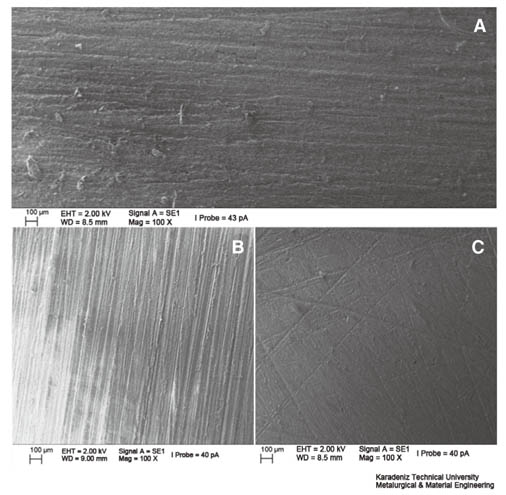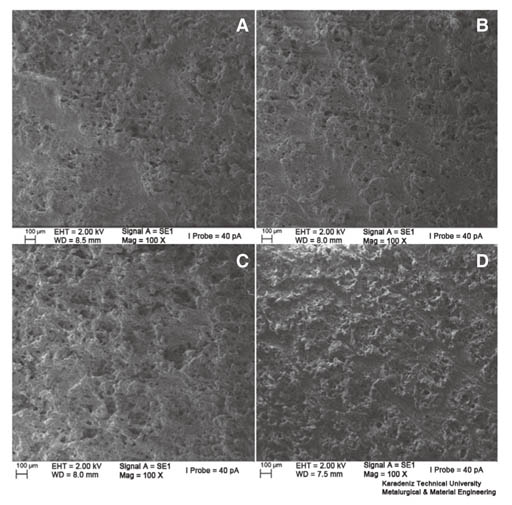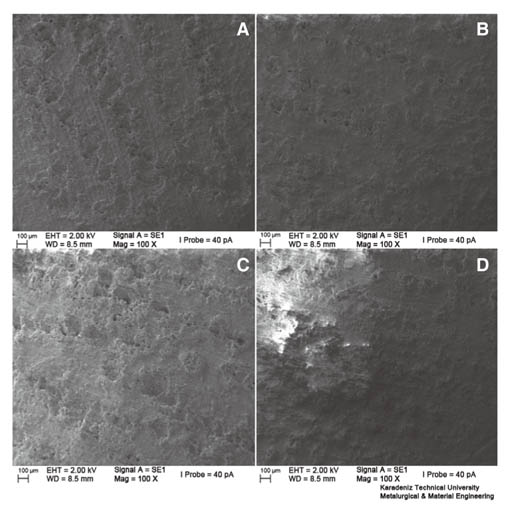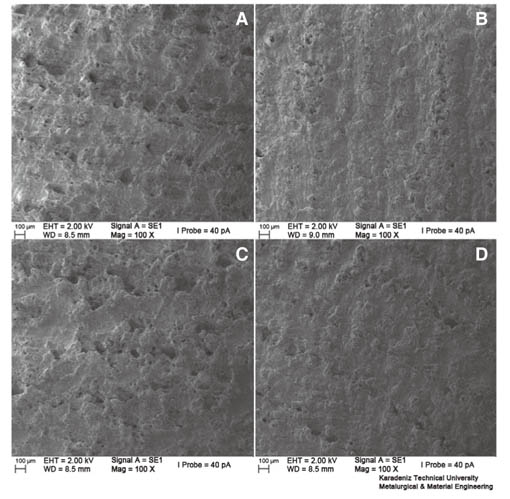J Adv Prosthodont.
2013 Aug;5(3):287-295. 10.4047/jap.2013.5.3.287.
Peel strength of denture liner to PMMA and polyamide: laser versus air-abrasion
- Affiliations
-
- 1Department of Prosthodontics, Faculty of Dentistry, Karadeniz Technical University, Trabzon, Turkey. fmkorkmaz@hotmail.com
- 2Department of Prosthodontics, Faculty of Dentistry, Izmir Katip Celebi University, Izmir, Turkey.
- 3Dental Materials Unit, Center for Dental and Oral Medicine, University of Zurich, Zurich, Switzerland.
- 4Department of Prosthodontics, Faculty of Dentistry, Afyon Kocatepe University, Afyonkarahisar, Turkey.
- 5Department of Prosthodontics, Faculty of Dentistry, Recep Tayyip Erdogan University, Rize, Turkey.
- KMID: 2118168
- DOI: http://doi.org/10.4047/jap.2013.5.3.287
Abstract
- PURPOSE
This study investigated the effect of laser parameters and air-abrasion on the peel strength of silicon-based soft denture liner to different denture resins.
MATERIALS AND METHODS
Specimens (N=180) were prepared out of three different denture base resins (Rodex, cross-linked denture base acrylic resin; Paladent, heat-cured acrylic resin; Deflex, Polyamide resin) (75 mm x 25 mm x 3 mm). A silicon-based soft denture liner (Molloplast B) was applied to the denture resins after the following conditioning methods: a) Air-abrasion (50 microm), b) Er,Cr:YSGG laser (Waterlase MD Turbo, Biolase Technology) at 2 W-20 Hz, c) Er,Cr:YSGG laser at 2 W-30 Hz, d) Er,Cr:YSGG laser at 3 W-20 Hz, e) Er,Cr:YSGG laser at 3 W-30 Hz. Non-conditioned group acted as the control group. Peel test was performed in a universal testing machine. Failure modes were evaluated visually. Data were analyzed using two-way ANOVA and Tukey's test (alpha=.05).
RESULTS
Denture liner tested showed increased peel strength after laser treatment with different parameters (3.9+/-0.4 - 5.58+/-0.6 MPa) compared to the control (3.64+/-0.5 - 4.58+/-0.5 MPa) and air-abraded groups (3.1+/-0.6 - 4.46+/-0.3 MPa), but the results were not statistically significant except for Paladent, with the pretreatment of Er,Cr:YSGG laser at 3 W-20 Hz. Polyamide resin after air-abrasion showed significantly lower peel strength than those of other groups (3.1+/-0.6 MPa).
CONCLUSION
Heat-cured acrylic resin, PMMA, may benefit from Er,Cr:YSGG laser treatment at 3 W-20 Hz irradiation. Air-abrasion of polyamide resins should be avoided not to impair their peel bond strengths to silicon-based soft denture liners.
Keyword
MeSH Terms
Figure
Reference
-
1. Bolayır G, Turgut M, Hubbezoğluİ , Doğan OM, Keskin S, Doğan A, Bek B. Evaluation of laser treatment on relinebase composites. J Adhesion. 2007; 83:117–127.2. Sertgöz A, Kulak Y, Gedik H, Taskonak B. The effect of thermocycling on peel strength of six soft lining materials. J Oral Rehabil. 2002; 29:583–587.3. Hatamleh MM, Watts DC. Bonding of maxillofacial silicone elastomers to an acrylic substrate. Dent Mater. 2010; 26:387–395.4. Usumez A, Inan O, Aykent F. Bond strength of a silicone lining material to alumina-abraded and lased denture resin. J Biomed Mater Res B Appl Biomater. 2004; 71:196–200.5. Haselden CA, Hobkirk JA, Pearson GJ, Davies EH. A comparison between the wear resistance of three types of denture resin to three different dentifrices. J Oral Rehabil. 1998; 25:335–339.6. Al-Athel M, Jagger R, Jagger D. Effect of ageing on the bond strength of a permanent denture soft lining material. J Oral Rehabil. 2002; 29:992–996.7. Tanimoto Y, Saeki H, Kimoto S, Nishiwaki T, Nishiyama N. Evaluation of adhesive properties of three resilient denture liners by the modified peel test method. Acta Biomater. 2009; 5:764–769.8. Machado AL, Breeding LC, Puckett AD. Effect of microwave disinfection on the hardness and adhesion of two resilient liners. J Prosthet Dent. 2005; 94:183–189.9. Sarac D, Sarac YS, Basoglu T, Yapici O, Yuzbasioglu E. The evaluation of microleakage and bond strength of a silicone-based resilient liner following denture base surface pretreatment. J Prosthet Dent. 2006; 95:143–151.10. Kawano F, Ohguri T, Koran A III, Matsumoto N, Ichikawa T. Influence of lining design of three processed soft denture liners on cushioning effect. J Oral Rehabil. 1999; 26:962–968.11. Jacobsen NL, Mitchell DL, Johnson DL, Holt RA. Lased and sandblasted denture base surface preparations affecting resilient liner bonding. J Prosthet Dent. 1997; 78:153–158.12. Pinto JR, Mesquita MF, Henriques GE, de Arruda Nóbilo MA. Effect of thermocycling on bond strength and elasticity of 4 long-term soft denture liners. J Prosthet Dent. 2002; 88:516–521.13. Aydin AK, Terzioğlu H, Akinay AE, Ulubayram K, Hasirci N. Bond strength and failure analysis of lining materials to denture resin. Dent Mater. 1999; 15:211–218.14. McCabe JF, Carrick TE, Kamohara H. Adhesive bond strength and compliance for denture soft lining materials. Biomaterials. 2002; 23:1347–1352.15. Pisani MX, Silva-Lovato CH, Malheiros-Segundo Ade L, Macedo AP, Paranhos HF. Bond strength and degree of infiltration between acrylic resin denture liner after immersion in effervescent denture cleanser. J Prosthodont. 2009; 18:123–129.16. Kawano F, Dootz ER, Koran A 3rd, Craig RG. Comparison of bond strength of six soft denture liners to denture base resin. J Prosthet Dent. 1992; 68:368–371.17. Waters MG, Jagger RG. Mechanical properties of an experimental denture soft lining material. J Dent. 1999; 27:197–202.18. Tugut F, Akin H, Mutaf B, Akin GE, Ozdemir AK. Strength of the bond between a silicone lining material and denture resin after Er:YAG laser treatments with different pulse durations and levels of energy. Lasers Med Sci. 2012; 27:281–285.19. Baysan A, Parker S, Wright PS. Adhesion and tear energy of a long-term soft lining material activated by rapid microwave energy. J Prosthet Dent. 1998; 79:182–187.20. Braden M, Wright PS, Parker S. Soft lining materials-a review. Eur J Prosthodont Restor Dent. 1995; 3:163–174.21. Anusavice KJ, Phillips RW. Phillip's science of dental materials. 11th ed. St. Louis: Elsevier;2003. p. 751–753.22. Lawrence J, Li L. Modification of the wettability characteristics of polymethyl methacrylate (PMMA) by means of CO2, Nd:YAG, excimer and high power diode laser radiation. Mater SciEng A. 2001; 303:142–149.23. Saraç YS, Başoğlu T, Ceylan GK, Saraç D, Yapici O. Effect of denture base surface pretreatment on microleakage of a silicone-based resilient liner. J Prosthet Dent. 2004; 92:283–287.24. Akin H, Tugut F, Mutaf B, Akin G, Ozdemir AK. Effect of different surface treatments on tensile bond strength of silicone-based soft denture liner. Lasers Med Sci. 2011; 26:783–788.25. Storer R. Resilient denture base materials. Part 1. Introduction and laboratory evaluation. Br Dent J. 1962; 113:195–203.26. Amin WM, Fletcher AM, Ritchie GM. The nature of the interface between polymethyl methacrylate denture base materials and soft lining materials. J Dent. 1981; 9:336–346.27. Akin H, Tugut F, Guney U, Kirmali O, Akar T. Tensile bond strength of silicone-based soft denture liner to two chemically different denture base resins after various surface treatments. Lasers Med Sci. 2013; 28:119–123.28. Zhang H, Fang J, Hu Z, Ma J, Han Y, Bian J. Effect of oxygen plasma treatment on the bonding of a soft liner to an acrylic resin denture material. Dent Mater J. 2010; 29:398–402.29. Minami H, Suzuki S, Ohashi H, Kurashige H, Tanaka T. Effect of surface treatment on the bonding of an autopolymerizing soft denture liner to a denture base resin. Int J Prosthodont. 2004; 17:297–301.30. Yanikoglu N, Denizoglu S. The effect of different solutions on the bond strength of soft lining materials to acrylic resin. Dent Mater J. 2006; 25:39–44.31. Shimizu H, Ikuyama T, Hayakawa E, Tsue F, Takahashi Y. Effect of surface preparation using ethyl acetate on the repair strength of denture base resin. Acta Odontol Scand. 2006; 64:159–163.32. Craig RG, Gibbons P. Properties of resilient denture liners. J Am Dent Assoc. 1961; 63:382–390.33. Baygin O, Korkmaz FM, Tüzüner T, Tanriver M. The effect of different enamel surface treatments on the microleakage of fissure sealants. Lasers Med Sci. 2012; 27:153–160.34. Botta SB, da Ana PA, Zezell DM, Powers JM, Matos AB. Adhesion after erbium, chromium:yttrium-scandium-galliumgarnetlaser application at three different irradiation conditions. Lasers Med Sci. 2009; 24:67–73.35. Başaran EG, Ayna E, Başaran G, Beydemir K. Influence of different power outputs of erbium, chromium:yttrium-scandium-gallium-garnet laser and acid etching on shear bond strengths of a dual-cure resin cement to enamel. Lasers Med Sci. 2011; 26:13–19.36. Wright PS. Characterization of the adhesion of soft lining materials to poly(methyl methacrylate). J Dent Res. 1982; 61:1002–1005.37. Mutluay MM, Ruyter IE. Evaluation of bond strength of soft relining materials to denture base polymers. Dent Mater. 2007; 23:1373–1381.38. Ucar Y, Akova T, Aysan I. Mechanical properties of polyamide versus different PMMA denture base materials. J Prosthodont. 2012; 21:173–176.39. Yunus N, Rashid AA, Azmi LL, Abu-Hassan MI. Some flexural properties of a nylon denture base polymer. J Oral Rehabil. 2005; 32:65–71.40. al-Athel MS, Jagger RG. Effect of test method on the bond strength of a silicone resilient denture lining material. J Prosthet Dent. 1996; 76:535–540.41. Kutay O. Comparison of tensile and peel bond strengths of resilient liners. J Prosthet Dent. 1994; 71:525–531.42. Elias CN, Henriques FQ. Effect of thermocycling on the tensile and shear bond strengths of three soft liners to a denture base resin. J Appl Oral Sci. 2007; 15:18–23.43. Süske E, Scharf T, Schaaf P, Panchenko E, Nelke D, Buback M, Kijewski H, Krebs HU. Variation of mechanical properties of pulsed laser deposited PMMA films during annealing. Appl Phys A. 2004; 79:1295–1297.44. Kulak-Ozkan Y, Sertgoz A, Gedik H. Effect of thermocycling on tensile bond strength of six silicone-based, resilient denture liners. J Prosthet Dent. 2003; 89:303–310.45. Oguz S, Mutluay MM, Dogan OM, Bek B. Effect of thermocycling on tensile strength and tear resistance of four soft denture liners. Dent Mater J. 2007; 26:296–302.
- Full Text Links
- Actions
-
Cited
- CITED
-
- Close
- Share
- Similar articles
-
- Investigation of bonding properties of denture bases to silicone-based soft denture liner immersed in isobutyl methacrylate and 2-hydroxyethyl methacrylate
- Mechanical and thermal properties of polyamide versus reinforced PMMA denture base materials
- Effect of surface treatment methods on the shear bond strength of auto-polymerized resin to thermoplastic denture base polymer
- The Effects Of Thermocycling On The Bond Strength Between Cobalt-Chromium Alloy And Denture Base Resin
- Shear bond strength between CAD/CAM denture base resin and denture artificial teeth when bonded with resin cement







